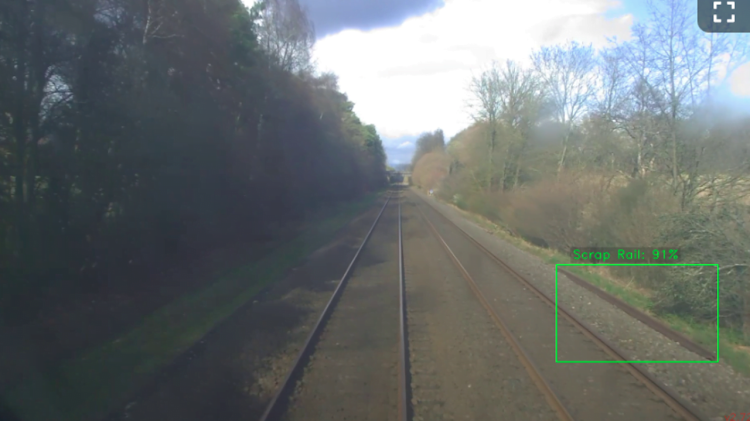Network Rail is using Artificial Intelligence software to help it locate forgotten scrap materials from the side of railway lines so they can be removed quickly and safer than how it is done now.
Network Rail Southern region is carrying out a trial of One Big Circle's video and AI technology to locate old railway materials that can either be reused or recycled.
By removing the materials from the side of the lines the risk of injury to colleagues from slips, trips, or falls will be reduced, and at the same time, the railway will appear a lot tidier.
On Network Rail's Wessex route, the largest causes of injury are ‘slips, trips and falls' with scrap materials on the side of the track being a significant hazard, especially as most work is carried out when it is dark.

A technology known as Automated Intelligent Video Review (AIVR) captures high-definition train's-eye-view video from across the rail network, and uploads it to the cloud where it is instantly accessible. AI is then used to analyse the video to find scrap rail, sleepers, and bags of ballast and map their locations using GPS. That will enable maintenance teams to plan how and when the items can be safely removed.
Network Rail has chosen its Wessex route for the trial, as it is one of the busiest on the rail network. The results of the trial will determine whether the technology is rolled out more widely. It is expected that as well as improving efficiency, the technology will also result in improved safety and financial savings.
Wayne Cherry, Network Rail senior innovations engineer, said: “Technology such as AIVR provides Network Rail with a brilliant opportunity to improve how efficient we are as a business.
“While AIVR is already in use across other parts of Network Rail, this will be the first time this technology has been used in this way with AI and could be a real game-changer.
“Not only is scrap on the side of the railway unsightly, but it can also become an obstacle during planned engineering work, block safe walkways or delay our teams accessing part of the railway infrastructure to make repairs during disruption.
“If we can become safer and more efficient with identifying and removing scrap material, it will not only help our colleagues stay safe, but benefit the wider rail industry, passengers and the taxpayer.”
Martyn Shaftoe, Network Rail's Wessex route health and safety advisor, who is leading this project, said: “We are delighted to be working in partnership with One Big Circle on this exciting project. I believe this technology will play an important role in helping keep our front-line colleagues safe, help us become more efficient in locating and removing scrap, as well as improving the overall condition of the railway for the benefit of our passengers and local residents.
“Unfortunately, over recent years, the railway has become somewhat of a dumping ground for discarded railway sleepers, scrap rail, redundant ballast bags and many other assets. The challenge we face is there is no definitive list of where these materials or assets are.
“The prospect of accurately locating scrap material using high-definition video footage and AI without the need for colleagues to walk along the railway is a huge safety improvement opportunity.”
“Financially, not only can some of the scrap material be recycled and any money accrued used to support running of the railway, but some of the leftover materials are also reusable. For example, Bomac concrete sleepers are no longer manufactured, but there is still a demand for them as replacements on sidings and on some stretches of track. Thanks to this technology, 40 of these sleepers have been identified on a site between Yeovil and Weymouth where they can be recovered and stored for future use across the business, preventing the need to buy costly new equivalents.”
“To be able to help the industry potentially save money by reusing or recycling this treasure-trove of scrap materials is a brilliant prospect and we look forward to hopefully rolling it out more widely across the business later in the year.”
Emily Kent, One Big Circle co-founder and director, said: “This is a really exciting application of AI developed in collaboration with Network Rail experts.
“The AIVR system collects high-quality lineside imagery from across the whole of the UK to help many different engineers and disciplines see what they need to see without attending site.
“Adding further intelligence to that data – as with this automatic detection and location of scrap rail and other lineside hazards – really enables you to hone in on specific issues and respond to them quickly and safely.”
It begs the question, why don’t the working gangs tidy uo after themselves?
That’s like too much hard work. They do the work, then move on to the next area. The other reason is sometimes, time is not on their side, get the work done and open the line to traffic.
It’s an incredibly complex and longwinded job getting access into the track, they have to start planning major jobs years in advance, minor jobs many months, and even urgent failures and defects are only given a short time to get on and repair it, often without enough resources of staff or equipment to get the old stuff off.
Ever since privatisation in the 90s, the overriding priority and consideration is, to get trains running again ASAP! If there’s a problem during a renewal, there’s people from on high pushing to cut the job short to get trains running again, so that penalty payments aren’t paid, and the simplest and least disruptive way to achieve that is, don’t remove the scrap or unused stuff. Then it becomes another person’s project to plan another possession to recover it!
They’ll never win, unless they’re allowed to build in extra time, or not expected to squeeze too much work into too short a time…